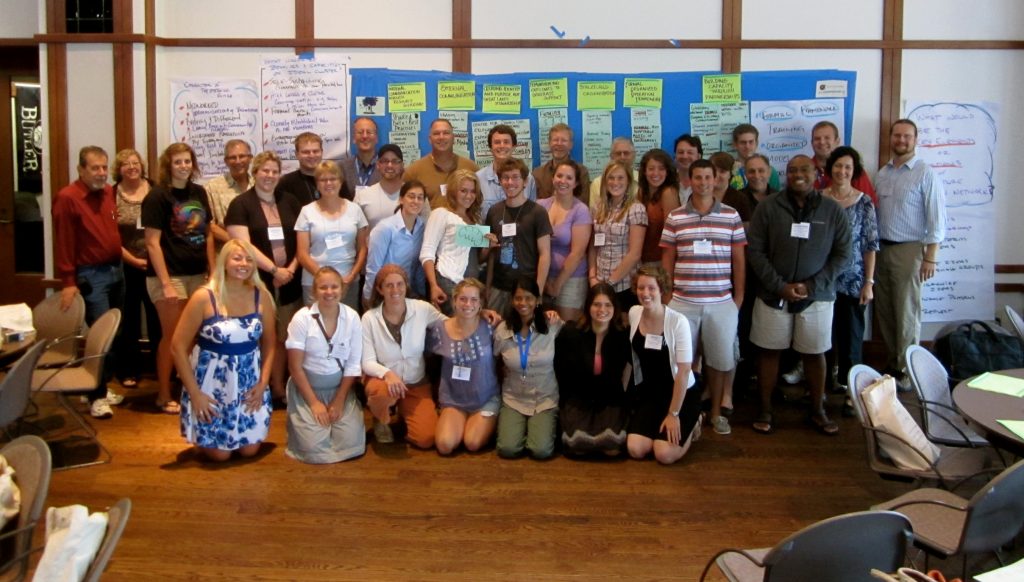
A project of the National Center for Science and Civic Engagement’s SENCER Center for Innovation – Great Lakes that is affiliated with the 21st Century Conservation Service Corps, GLISTEN (the Great Lakes Innovative Stewardship Through Education Network) engages undergraduate students in environmental service-learning components of STEM (science, technology, engineering, and mathematics) coursework on their campuses.
The activities of these components enhance the capacity of governmental and community-based organizations involved in restoration and stewardship of the Great Lakes ecosystem. These activities also enhance the STEM education of undergraduates in higher education institutions in the Great Lakes ecosystem.
These institutions, along with their community-based partners, are organized into Collaborative Clusters in the 8 Great Lakes states.
Each GLISTEN Cluster’s campus-community partnerships are facilitated by a corps of paraprofessional undergraduate student leaders who are becoming the next generation of Great Lakes stewards.
About GLISTEN
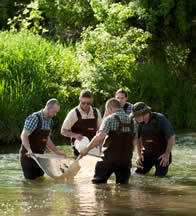
A project of the National Center for Science and Civic Engagement, GLISTEN (the Great Lakes Innovative Stewardship Through Education Network) engages undergraduate students in environmental service-learning components of STEM (Science, Technology, Engineering, and Mathematics) coursework on their campuses. These components enhance the capacity of governmental and community-based organizations involved in restoration and stewardship of the Great Lakes ecosystem.
From Rochester, New York to Duluth, Minnesota, undergraduates at nearly 30 colleges and universities are enrolling in GLISTEN-affiliated STEM coursework with environmental service-learning components based on the ideals of SENCER (Science Education for New Civic Engagements and Responsibilities). Activities in these components vary from invasive species control to wetland restoration to water quality monitoring, and are directly linked to content-based learning outcomes of the courses into which they have been incorporated. Engagement in these activities deepens students’ understanding of technical aspects of course content as well as how this technical content informs attempts to solve complex and challenging real-world problems like restoration of the fragile Great Lakes ecosystem. GLISTEN is affiliated with the SENCER Center for Innovation – Great Lakes.
The Collaborative Clusters of GLISTEN consist of 2-year and 4-year public and private higher education institutions, governmental and community-based environmental agencies, and institutions of informal science education situated in or near environmental “hot spots” or Areas of Concern in the Great Lakes ecosystem. Working synergistically, these partners link curricular and community-based venues for implementation and dissemination of GLISTEN’s environmental service-learning activities and outcomes.
A select group of Undergraduate Stewardship Liaisons provide peer leadership in the GLISTEN project. In addition to providing direct service to governmental and community-based environmental GLISTEN partner organizations, they build the capacity of these organizations to form mutually-beneficial partnerships with GLISTEN-affiliated institutions of higher education by
- assisting faculty with the development, implementation, and evaluation of environmental service-learning components of undergraduate STEM coursework benefiting those organizations and
- leading their peers in implementing those environmental service-learning components on the ground.
Liaisons receive special training for their unique role, collaborate regularly with other liaisons in their Clusters, and participate in opportunities for networking across Clusters and disseminating project outcomes at local and regional events and conferences.
Program Overview
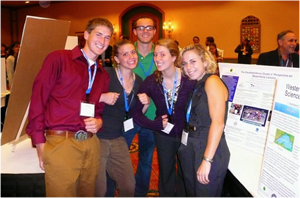
GLISTEN received funding through the Learn and Serve America Higher Education program of the Corporation for National and Community Service and the Environmental Protection Agency. GLISTEN is a Great-Lakes-wide environmental service-learning project sponsored by NCSCE that supports the integration of Great Lakes ecosystem stewardship and restoration with undergraduate coursework in the STEM disciplines through the incorporation of environmental service learning components into these courses.
Vision and Mission: By focusing undergraduate curriculum development efforts, academic courses, research, fieldwork, and other resources on a single but multi-faceted civic issue, GLISTEN will build the capacity of STEM faculty and departments to:
- improve learning in the STEM disciplines
- engage students in direct action (i.e., service-learning) and community-based research to benefit resource-strapped governmental and community-based organizations
- position students to take advantage of “green” professional opportunities upon graduation,
- provide students with the 21st Century skills (such as critical thinking, capacity for collaboration, as well as associated civic engagement skills), and
- help students as well as members of the involved communities become enlightened stakeholders who practice active stewardship behaviors in their private and civic lives.
How GLISTEN works: GLISTEN is organized into “Collaborative Clusters” of higher education institutions, community-based organizations and institutions of information science education (ISE) in the 8 Great Lakes states. The Cluster model promotes synergy among the collaborating institutions and effective service-learning experiences for undergraduates in the STEM courses linked to the project. Regular communication among the Clusters promotes sharing and dissemination of best practices and curricular models. The Clusters share goals in the following three areas:
- Undergraduate student leadership development and career preparation Colleges in each cluster recruit and employ undergraduate stewardship liaisons, who serve as the logistical “glue” linking participating faculty and community-based organizations who will benefit from GLISTEN-sponsored service-learning and research activities. These students provide critical project leadership, ensuring that the cluster maintains an optimal balance among curricular goals, community needs, and student interests. Student leaders also receive specialized training to prepare them to excel in the “green jobs” of the future.
- Curriculum development, dissemination and the creation of a community of practice In each cluster, faculty collaborate across institutions to integrate on-the-ground stewardship activities that improve learning in their undergraduate STEM coursework. Summer Institutes and other resources of SENCER support curriculum development on GLISTEN-affiliated campuses.
- Evaluation and assessment to promote program effectiveness To assess learning and civic engagement outcomes, GLISTEN-affiliated faculty utilize the Student Assessment of Learning Gains (SALG) and other assessment resources of the National Center for Science and Civic Engagement.
Clusters
Calumet
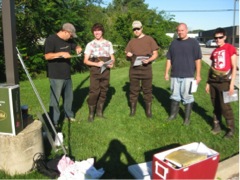 The students, faculty, and community partners of the Northwest Indiana Collaborative Cluster participated in a summer workshop hosted by the National Parks Conservation Association (NPCA) to restore Cowles Bog in the Indiana Dunes National Lakeshore (IDNL). The workshop, which was held at the Indiana Dunes National Lakeshr’s Dunes Learning Center, included presentations by experts in conservation, policy, and advocacy who emphasized the critical role that public lands play in the preservation and restoration of degraded wetlands and ecosystems. GLISTEN students planted native species alongside IDNL staff, members of the Student Conservation Association, and students from Illinois, Wisconsin, and Michigan. This “hands on” experience was the perfect way to connect the GLISTEN Cluster with the unique natural resources that exist on the southern shores of the Lake Michigan watershed.
The students, faculty, and community partners of the Northwest Indiana Collaborative Cluster participated in a summer workshop hosted by the National Parks Conservation Association (NPCA) to restore Cowles Bog in the Indiana Dunes National Lakeshore (IDNL). The workshop, which was held at the Indiana Dunes National Lakeshr’s Dunes Learning Center, included presentations by experts in conservation, policy, and advocacy who emphasized the critical role that public lands play in the preservation and restoration of degraded wetlands and ecosystems. GLISTEN students planted native species alongside IDNL staff, members of the Student Conservation Association, and students from Illinois, Wisconsin, and Michigan. This “hands on” experience was the perfect way to connect the GLISTEN Cluster with the unique natural resources that exist on the southern shores of the Lake Michigan watershed.
Faculty
Indiana University Northwest
Dr. Peter Avis
pavis (at) iun.edu
Dr. Erin Argyilan
eargyila (at) iun.edu
Ivy Tech CC of Indiana
Louis Fadel
lfadel (at) ivytech.edu
Dr. Laura Rosillo
lrosillo (at) ivytech.edu
Karen Dunbar
kdunbar3 (at) ivytech.edu
Valparaiso University
Dr. Laurie Eberhardt
laurie.eberhardt (at) valpo.edu
Dr. Thomas Goyne
thomas.goyne (at) valpo.edu
Dr. Sara Dick
sara.dick (at) valpo.edu
Purdue University Northcentral
Dr. Robin Scribailo
rscribailo (at) pnc.edu
Dr. Vanessa Quinn
vquinn (at) pnc.edu
Chicago State University
Dr. Karel Jacobs
kjacobs (at) csu.edu
Past Stewardship Liaisons
Katrina Werner, Indiana University Northwest
Jason Lundquist, Ivy Tech CC of Indiana
Maximilian Paul, Valparaiso University
Steve Rodriguez, Purdue University Northcentral
Angelesha Jones, Chicago State University
Brittny Ridenbaugh, Chicago State University
Community Partners
Indiana Dunes National Lakeshore
Northwest Indiana Restoration Monitoring Initiative
Save the Dunes
Shirley Heinze Land Trust
Erie
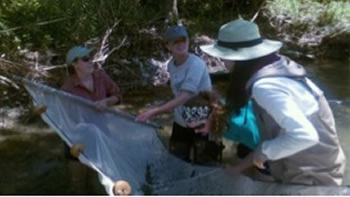 Gretchen Fairley
Gretchen Fairley
Director of Service-Learning
Gannon University
Colin Hurley
Director of Service-Learning
Mercyhurst University
Cluster Accomplishments
2010 – 2012
Cluster News
2011 – 2012
Lake Ontario
 The Lake Ontario Cluster (Rochester Institute of Technology, SUNY Brockport, and Monroe Community College) has approached the curriculum goal of infusing Great Lakes water quality issues and service learning into courses from a variety of angles. At SUNY Brockport and MCC, the focus has been to introduce Great Lakes modules into introductory course and to expand those over time. SUNY Brockport has also involved the work of a USL in lab exercises involving benthic macroinvertebrates. At RIT, the focus has been on mid-level and capstone courses (by catherine). USLs and community partners have worked with Environmental Science Field Skills, Great Lakes I and II, and the Environmental Science Capstone Seminar to expand the scope of group projects and enhance the outreach component. For the past few years, these projects have been presented at Imagine RIT, a public festival that showcases RIT research and innovation. Over 40,000 people attended the 2011 festival, and our exhibit was “liked” by the RIT Alumni Association (we got a sticker!). RIT capstone projects are working with community partners on river otter monitoring, water quality education and outreach, and a series of fracking articles for community newspapers (pros and cons of fracking and a resource library).
The Lake Ontario Cluster (Rochester Institute of Technology, SUNY Brockport, and Monroe Community College) has approached the curriculum goal of infusing Great Lakes water quality issues and service learning into courses from a variety of angles. At SUNY Brockport and MCC, the focus has been to introduce Great Lakes modules into introductory course and to expand those over time. SUNY Brockport has also involved the work of a USL in lab exercises involving benthic macroinvertebrates. At RIT, the focus has been on mid-level and capstone courses (by catherine). USLs and community partners have worked with Environmental Science Field Skills, Great Lakes I and II, and the Environmental Science Capstone Seminar to expand the scope of group projects and enhance the outreach component. For the past few years, these projects have been presented at Imagine RIT, a public festival that showcases RIT research and innovation. Over 40,000 people attended the 2011 festival, and our exhibit was “liked” by the RIT Alumni Association (we got a sticker!). RIT capstone projects are working with community partners on river otter monitoring, water quality education and outreach, and a series of fracking articles for community newspapers (pros and cons of fracking and a resource library).
Faculty
Monroe Community College
Ernie Mellas
Department of Biology
emellas (at) monroecc.edu
The New York State College of Brockport
Dr. James Haynes
Environmental Science and Biology
jhaynes (at) brockport.edu
Rochester Institute of Technology
Dr. Elizabeth Dicesare
Environmental Science
ewdsbi (at) rit.edu
Dr. Christine Keiner
Science Technology and Society/Public Policy
cmkgsh (at) rit.edu
Dr. Christy Tyler
Environmental Science
actsbi (at) rit.edu
Past Stewardship Liaisons
Laura Lanzafame, Monroe Community College and SUNY Brockport
Matt Paufve, Monroe Community College and Hobart William Smith College
Johnny Ramus, Monroe Community College and SUNY Geneseo
Matt Laine, The New York State College of Brockport
Samantha Gonzalez, Rochester Institute of Technology
Lisa Kratzer, Rochester Institute of Technology
Caitlin Treuting, Rochester Institute of Technology
Theo Petenzi, Rochester Institute of Technology
Community Partners
High Acres Nature Area (HANA)
Cindy Jessop
CJessop (at) wm.com
Monroe County Soil & Water Conservation District
Kelly Emerick
Executive Director
kelly.emerick (at) ny.nacdnet.net
www.monroecountyswcd.org
Wayne County Soil & Water Conservation District
Lindsey M. Gerstenslager
District Manager
WayneSWCD1 (at) rochester.rr.com
Kenny Nelson
Education Animal Programs and Training Coordinator
Seneca Park Zoo Society
knelson (at) senecazoo.org
Cluster ResourcesCluster Accomplishments
2010-2012 Cluster Accomplishments
Outreach Poster 1
Outreach Poster 2
Milwaukee
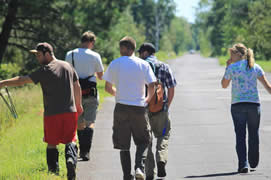
Faculty
University of Wisconsin – Milwaukee
Dr. Timothy Ehlinger
Associate Professor
Biology
ehlinger (at) uwm.edu
Milwaukee Area Technical College
Kathy Bates
Program Coordinator/Instructor
Environmental Health
batesks (at) matc.edu
Past Stewardship Liaisons
Sarah Clark, University of Wisconsin-Milwaukee
Michael Campagnola, Milwaukee Area Technical College
Todd Brennan
Northeast Ohio
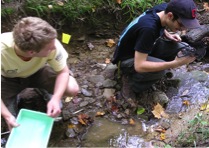 Most of us have looked at our water, electric, and gas meters at least once, and tried to figure out how the meter readings relate to the utility bills we receive every month. But how many of us know at any point in time exactly how much water we are using and electricity we are consuming as a whole community? Or whether the creek or river flowing through our community is at or near flood stage – in real time?
Most of us have looked at our water, electric, and gas meters at least once, and tried to figure out how the meter readings relate to the utility bills we receive every month. But how many of us know at any point in time exactly how much water we are using and electricity we are consuming as a whole community? Or whether the creek or river flowing through our community is at or near flood stage – in real time?
At Oberlin College, faculty and students affiliated with NCSCE’s GLISTEN project have created an “Environmental Dashboard” which does just that for residents of Oberlin, Ohio.
Faculty
Case Western Reserve University
Jean Burns
Biology
jbm122 (at) case.edu
Joseph F. Koonce
Biology
jfk7 (at) case.edu
Oberlin College
John Petersen
Environmental Studies
john.petersen (at) oberlin.edu
Kent State University
Dan Ross
daross (at) kent.edu
Hiram College
Dennis J. Taylor
Biology
taylordj (at) hiram.edu
Past Stewardship Liaisons
Deanna Drenten, Case Western Reserve University
Shane Clark, Oberlin College
Theresa Wolanin, Kent State University
Ryan Astalos, Hiram College
Maura Brett-Eiger, Hiram College
Sarah Loyer, Hiram College
Community Partners
Cleveland Metroparks
Jennifer Grieser
jmg2 (at) clevelandmetroparks.com
Cuyahoga Valley National Park
Christopher Davis
Christopher_Davis (at) nps.gov
Portage Park District
Chris Craycroft
ccraycroft (at) portageparkdistrict.org
Lorain County Community Development
Christina Znidarsic
cznidarsic (at) loraincounty.us
Cluster Accomplishments
2010 – 2012
Cluster Resources
Cluster Google Site
Northwest Ohio
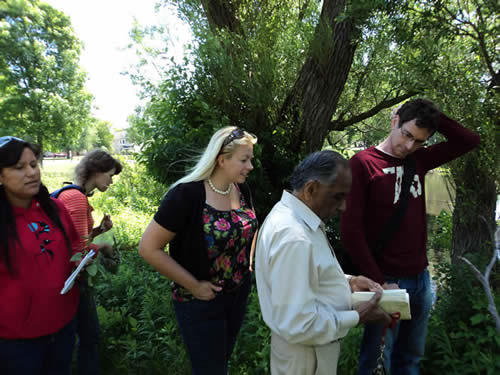 Defiance College undergraduates in Professor Doug Kane’s Biology courses have learned about environmental issues facing the Maumee River watershed and western Lake Erie by examining water quality at sites along the Maumee River from Fort Wayne (Indiana) to Waterville (Ohio).
Defiance College undergraduates in Professor Doug Kane’s Biology courses have learned about environmental issues facing the Maumee River watershed and western Lake Erie by examining water quality at sites along the Maumee River from Fort Wayne (Indiana) to Waterville (Ohio).
Faculty/Staff
Bowling Green State University
Dr. Robert Midden
Associate Professor, Department of Chemistry
midden (at) bgsu.edu
Defiance College
Dr. Douglas Kane
Associate Professor, Department of Biology
dkane (at) defiance.edu
Lourdes University
Dr. James Minesky
Associate Professor, Department of Biology and Health Sciences
jminesky (at) lourdes.edu
Owens Community College
Krista Kiessling
Director of Service Learning, Civic Engagement and Leadership
krista_kiessling (at) owens.edu
Past Stewardship Liaisons
Nadya Mirochnitchenko, Bowling Green State University
Alison Rifenburgh, Defiance College
Cynthia Carnicom, Lourdes University
Codie Keeler, Owens Community College
Christina Perry, Owens Community College
Jordyn Windnagle, Owens Community College
Community Partners
Upper Maumee Watershed Parnership
Stephanie Singer
ssinger (at) defiance-county.com
Metroparks of the Toledo Area
Krista Underwood
krista.underwood (at) metroparkstoledo.com
Olander Park System
Wood County Health Department
Northwest Agricultural Research Station, OSU Agricultural Research and Development Center
Ohio EPA
Saginaw Bay
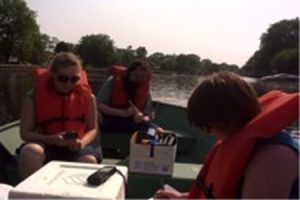 Since 2010, the Saginaw Bay Watershed Collaborative Cluster has made the Kawkawlin River the focus of its environmental service-learning efforts. Faculty and students from Saginaw Valley State University and its two-year partner Delta College have been working in collaboration with the Kawkawlin River Watershed Property Owner’s Association and Saginaw Area Storm Water Authority to collect baseline data that will help facilitate implementation of a watershed stewardship plan addressing problems such as sedimentation, bacterial contamination, impaired fisheries, and excess nutrients such as phosphorus.
Since 2010, the Saginaw Bay Watershed Collaborative Cluster has made the Kawkawlin River the focus of its environmental service-learning efforts. Faculty and students from Saginaw Valley State University and its two-year partner Delta College have been working in collaboration with the Kawkawlin River Watershed Property Owner’s Association and Saginaw Area Storm Water Authority to collect baseline data that will help facilitate implementation of a watershed stewardship plan addressing problems such as sedimentation, bacterial contamination, impaired fisheries, and excess nutrients such as phosphorus.
Faculty
Delta College
Kristopher Nitz
Biology
kristophernitz (at) delta.edu
Jacob Vanhouten
Biology
jwvanhou (at) delta.edu
Saginaw Valley State University
Marty Arford
Geography
mrarford (at) svsu.edu
Brent Hedquist
Geography
bchedqui (at) svsu.edu
Arthur Martin
Biology
almarti2 (at) svsu.edu
Edward Meisel
Chemistry
ecmeisel (at) svsu.edu
Amanda Ross
Biology
aross (at) svsu.edu
Central Michigan University
Dale LeCaptain
Biology
lecap1dj (at) cmich.edu
Past Stewardship Liaisons
Kristy Miller, Delta College
Taylor Rupp, Saginaw Valley State University
Amber Miller, Central Michigan University
Russell A. Beaubien
russb (at) spicergroup.com
Dave Bledsoe
dmbledso (at) delta.edu
Western Lake Superior
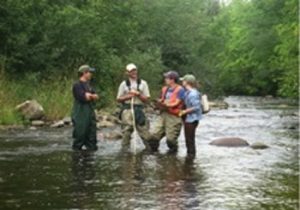 After a highly contentious debate and party-line vote in the Wisconsin legislature a few years ago, Governor Scott Walker signed a bill that would permit mining in an Iron County area that includes the headwaters of the Bad River, a major tributary of Lake Superior. Whatever the outcome of the mining controversy in northern Wisconsin, Northland College’s faculty and students have ensured that community members will have a body of actionable data with which they can participate as scientifically informed citizens in determining the future economic development and environmental protection of their region of the state.
After a highly contentious debate and party-line vote in the Wisconsin legislature a few years ago, Governor Scott Walker signed a bill that would permit mining in an Iron County area that includes the headwaters of the Bad River, a major tributary of Lake Superior. Whatever the outcome of the mining controversy in northern Wisconsin, Northland College’s faculty and students have ensured that community members will have a body of actionable data with which they can participate as scientifically informed citizens in determining the future economic development and environmental protection of their region of the state.
Faculty
University of Wisconsin-Superior
Nick Danz
Plant Sciences, Ecology
ndanz (at) uwsuper.edu
Northland College
Sharon Anthony
Biology
santhony (at) northland.edu
Lake Superior College
Glenn Merrick
Biology
g.merrick (at) lsc.edu
Past Stewardship Liaisons
Allie Quick, University of Wisconsin-Superior
Stephanie Lein, Northland College
Community Partners
Duluth Stream Corps
Tim Beaster
Project Coordinator
tim (at) communityactionduluth.org
St. Louis River Alliance
Julene Boe
Executive Director
slrcac (at) stlouisriver.org
City of Superior
Mary Morgan
Administrator, Parks and Recreation
morganm (at) ci.superior.wi.us
Lake Superior National Estuarine Research Reserve
Sue O’Halloran
sohallor (at) uwsuperior.edu
Bad River Watershed Association
Tony Janisch
Executive Director
janisch (at) badriverwatershed.org
Bad River Natural Resources Air Quality Program
Nathan Kilger
airquaility (at) badriver-nsn.gov
Western Michigan
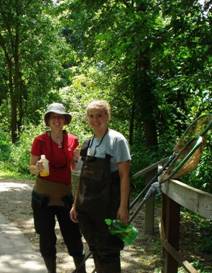 Mapping Community Gardens in Muskegon
Mapping Community Gardens in Muskegon
This project included gathering data and GPS photographs to map Community Gardens in Muskegon, MI. A short survey was administered and photographs taken of each garden. Information gathered is being used by The Center for Economic Security (Muskegon County) and The Muskegon County Health Department. This information can also be used to help gardeners connect and share best sustainable practices, problems & solutions and ideas in the production of locally grown organic food.
Faculty
Calvin College
David Koetje
Biology
dkoetje (at) calvin.edu
Grand Valley State University
Elena Lioubimtseva
Geography and Planning
lioubime (at) gvsu.edu
Janet Vail
Annis Water Resources Institute
vailj (at) gvsu.edu
Past Stewardship Liaisons
Emily Anne Fuller, Calvin College
John Scott, Grand Valley State University
Community Partners
Blandford Nature Center
Annoesjka Steinman
Executive Director
Kristin Tindall
Education Director
Muskegon Conservation District (White Lake and Muskegon Areas of Concern)
Jeffrey Auch
Ottawa County Parks
Melanie Manion
West Michigan Environmental Action Council (WMEAC)
Rachel Hood
Executive Director
Resources
Student Leadership
A Guide to Student Leadership Development Through Service
Leadership Reconsidered: Engaging Higher Education in Social Change
Resources for Undergraduate Stewardship Liaisons
The links below provide useful information for undergraduate stewardship liaisons. They include resources about the Great Lakes, environmental service-learning curriculum development, student leadership development, effective campus-community partnerships, and program evaluation and assessment tools. USLs can find some helpful tips from the Society on Conservation Biology on preparing and making poster presentations, making oral presentations, and writing abstracts for conference presentations here.
The Undergraduate Stewardship Liaison Role
Undergraduate Stewardship Liaisons – What’s My Role?
Undergraduate Stewardship Liaisons are the key to successful campus-community partnerships that engage undergraduate students in environmental service-learning activities focused on stewardship and restoration of the Great Lakes ecosystem.
Role-related resources
Great Lakes Resources
Curriculum Development
A Faculty Guide to Service Learning in Higher Education (New Hampshire Campus Compact)
Principles of Good Practice for Service-Learning Pedagogy
SENCER Course Core Elements Rubric 2.0
Campus-Community Partnerships
Achieving The Promise of Community- Higher Education Partnerships – Community Partners Speak Out!
Building Partnerships With College Campuses
Community Partnership Seminar (University of San Francisco)
Guide To Reciprocal Campus-Community Partnerships (Portland State University)
A Meeting of the Minds: A Handbook for Community – Campus Engagement
Evaluation and Reporting
21st Century Conservation Service Corps Affiliation
GLISTEN has been affiliated with the 21st Century Conservation Service Corps (www.21CSC.org) since 2013. This federal Corps has 3 major goals:
Put Americans to Work
The 21CSC provides service, training, education and employment opportunities for thousands of young Americans and veterans, including low income and disadvantaged youth.
The 21CSC protects, restores and enhances public and tribal lands and waters as well as natural, cultural, and historical resources and treasures. By producing high-quality, cost-effective project work, the 21CSC also increases public access and use while spurring economic development and outdoor recreation.
Build America’s Future
Through service to America, the 21CSC helps develop a generation of skilled workers, educated and active citizens, future leaders, and stewards of natural and cultural resources, communities, and the nation.
Background
The 21CSC is a bold national effort to put America’s youth and veterans to work protecting, restoring, and enhancing America’s Great Outdoors. Recognizing the need for job opportunities for youth and returning veterans, for restoration of our natural resources, to connect Americans to the country’s lands and waters, to effectively recruit the next generation of public employees, and to develop the next generation of conservation stewards, the Secretary of the Department of the Interior, on behalf of the America’s Great Outdoors Council, formed a Federal Advisory Committee (FACA) to develop recommendations for the establishment of the 21CSC. The FACA was comprised of representatives from Federal agencies, the outdoor industry, and non-profit youth and conservation corps. In addition to providing recommendations, the FACA also identified 21 CSC goals and principles, which were slightly modified and adopted by the Federal 21CSC National Council.
